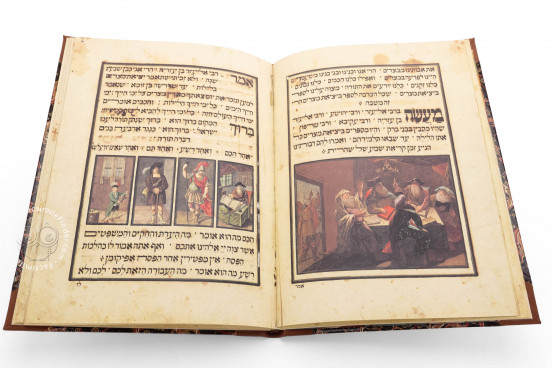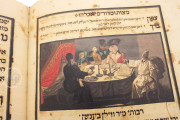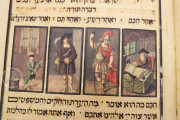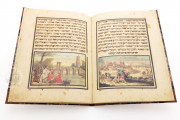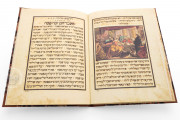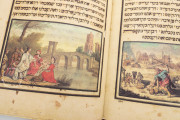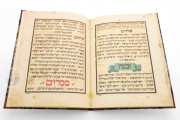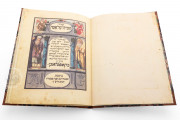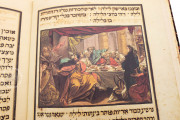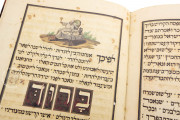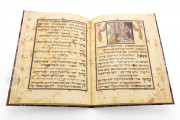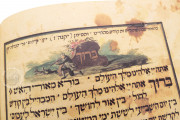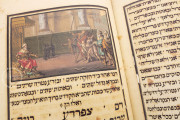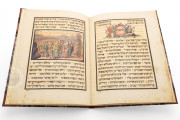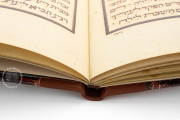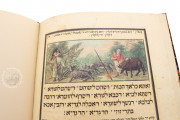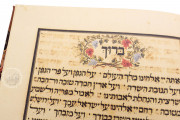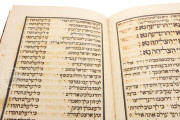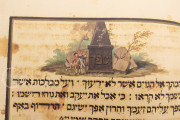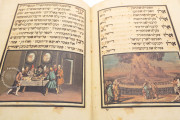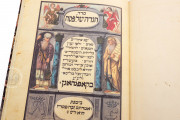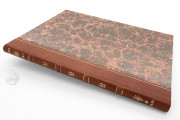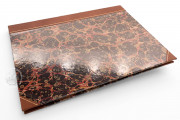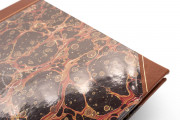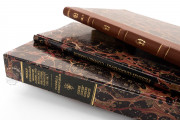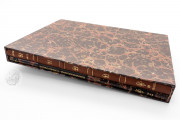The Darmstadt Pessach Haggadah, Hebrew for "Passover Narration," is a text describing the Jewish religious meal held before the beginning of the Pesah festival. While the Torah never bore illustrations, the Bible, the Mahzor, and the Pesah are among the most eminent illustrated Jewish religious manuscripts. The fact that in modern times, long after the invention of print, many Jewish liturgical texts were still copied by hand and exceptionally decorated is impressively documented in this manuscript.
The Darmstadt Pessach Haggadah: a Modern though Traditional Work
The Darmstadt Pessach Haggadah, penned in 1769 at Copenhagen, was written and skilfully decorated by Yehuda Leib ben Eliyya Ha-Cohen. The texts and illuminations describe various Biblical, ritual, and eschatological aspects of liturgy. Yehuda Leib Ha-Cohen's miniatures are detailed and precise: just like small paintings, by illustrating themes from the Pesah-Haggada they provide an insight into the life and times of this period.
The Jewish Community in Denmark
The growth of Jewish communities in Denmark dates back to the seventeenth century, when King Christian IV welcomed many of them for economic and political reasons. Among the largest groups was that of Copenhagen, which counted roughly a hundred thousand members. The community had a largely cosmopolitan feel to it and fostered a wide range of cultural activities. The Jewish population in Denmark was quite peaceful and prosperous: economy was thriving and artists' commissions numerous.
A Liturgical Handbook for the Feast of Liberation
The Darmstadt Pessach Haggadah recounts the liberation of the people of Israel from slavery in Egypt and their exodus to the Promised Land. The author's intention was that of making the narration incredibly modern by passing the message of liberation from one generation to the next. The Pesah festival, which starts on the fourteenth day of the month of Nisan, (the first spring full moon), is an eight-day long celebration. At night, each family eats lamb, unleavened bread (matzah), bitter herbs, and wine. Over the centuries, a fixed order (seder) was decided for this 'liturgical meal,' the celebrations following in this order. The latter was later systematized in a small booklet named Pesah-Haggada. The text includes biblical narratives, psalms, hymns, and much more. Traditionally, the family head read it during the first and second nights of Pesah: since the book was actually used during the sacred meal, manuscripts of the Pessach Haggadah often contain signs of usage such as wine stains.
Yehuda Leib ben Eliyya Ha-Cohen
The scribe and illuminator of the Darmstadt Pessach Haggadah, Yehuda Leib Ha-Cohen, was born in Lissa (Poland). Two Haggadot were penned by him during his stay in Denmark, the Darmstadt Codex of 1769 and another one in 1779. Jewish illuminators were always very 'traditional' craftsmen. Unlike his colleagues, Yehuda based his work on European creations, specifically Danish. Though his style is peculiar and unique, he was obviously inspired by other masteripeces, such as the Icones Biblicae by Matthäus Merian and the Haggadot of Amsterdam. His influences also included the etchings of Daniel Nikolaus Chodowiecki. Yehuda's landscape paintings are reminiscent of the French classical period and his architectural drawings of Baroque buildings in Copenhagen. His typically Rococo interior scenes display numerous nuances of light and shade, all of which convey a magical atmosphere.
We have 1 facsimile edition of the manuscript "Darmstadt Pessach Haggadah": Die Pessach-Haggadah facsimile edition, published by Akademische Druck- u. Verlagsanstalt (ADEVA), 1989
Request Info / Price
